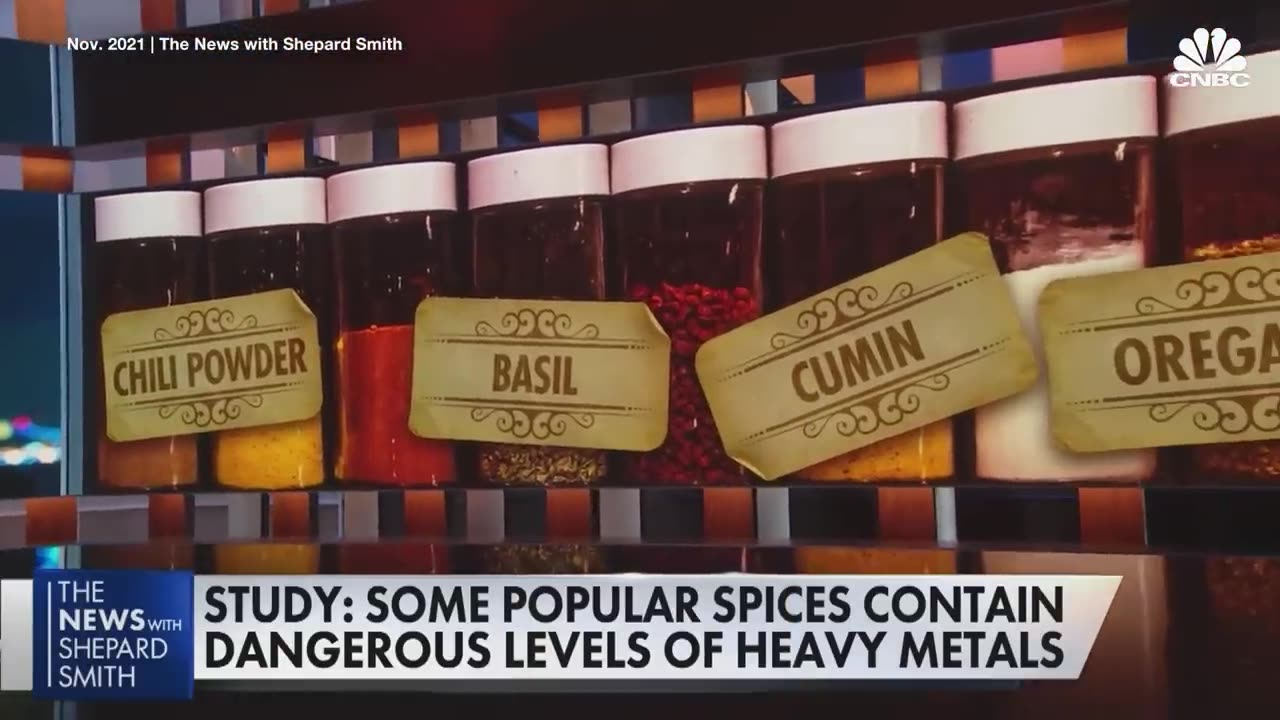Premium Only Content

How Americans And World Are Tricked Into Buying Fake Food Learn the Difference ?
The food in your kitchen cabinets may not be what it seems. Fraudsters motivated by economic gain secretly infiltrate the global food market through a variety of means, including counterfeits, dilutions, substitution and mislabeling, according to the Global Food Safety Initiative. This may not only harm consumers’ wallets, but it can also put public health and safety at risk. Some estimates say food fraud affects at least 1% of the global food industry at a cost as high as $40 billion a year, according to the FDA. Well, real food is basically any food that is consumed and provides nutritional support and essential nutrients for your body: such as carbohydrates, fats, proteins, vitamins, or minerals (It’s usually of plant or animal origin), while fake food is made in factories with added chemicals and sugars, and is bad for you. It’s basically food that tastes good but is high in calories having little nutritional value. There’s a saying stating: If it came from a plant- Eat It. If it was made in a plant- Don't. It’s that Simple. But even simple rules can be hard to follow. And there’s clear proof of that from the world we live in today. About 80% of all foods on supermarket shelves didn’t exist 100 years ago, meaning, a long time ago, when the industrial revolution first started growing more quickly, everyone was excited to see what new foods could be made in factories. And at first, honestly, it wasn’t that bad… That is, until everyone started getting used to the new foods. We dropped the organic farm-made fruits and vegetables, we stopped making homemade healthy dishes and we started buying sugary snacks and fast foods. Why? Because it tasted better, it was faster, it saved us time, it was convenient, and it was everywhere. Every corner we look we see a place to eat food, we see fast food restaurants. At every place we scan we see a McDonald’s, a Pizza Hut and Dunkin Donuts. So this new food that we’re eating, it’s convenient and cheap and tastes really good. So doesn’t that make it good overall? Doesn’t that make it a positive part of the industrial revolution? Hahahaha… No. Not at all. Processed foods made in factories have all sorts of chemicals to make them “better”. These chemicals make the food last longer and taste tastier. The kinds of chemicals put into fake foods are extremely unhealthy and detrimental to your health and are intended to get you addicted. Oils and sugars are also added to make the food taste better which also leads to addiction. The thing is that when people start, they can’t stop, and then it only gets worse from there, as seen worldwide.
Food is the cheapest it's ever been right now. We live in an era where a fast food cheeseburger costs less than most supermarket vegetables. The food industry has become all about creating an abundant supply of food for less money, and this is where fillers come in. Food fillers are additives that help bulk up the weight of a food with less expensive ingredients, which helps keep the price down. Fillers are mainly found in the meat processing industry, and processed meats, like hamburger and sausage, are the best candidates to contain fillers. This is because meats are big ticket items in a food budget. Using meat fillers and extenders can lower the cost of meats by 10 to 30 percent [source: Heinz and Hautzinger].
Non-meat Fillers
Some non-meat fillers are starchy in their makeup, making them high in carbohydrates and low in nutritional value. One type of non-meat filler is known as a cereal binder and usually contains some combination of flours and oatmeal. These are often used in hot dogs. Other common fillers include bread crumbs and maltodextrine, a food additive made from starch. Rusk, a dry biscuit, can often be found in cheap sausages, and soya protein is a common ingredient in cheap hamburgers. Adding copious amounts of cheap fillers is a common practice in meat processing operations in developing countries to help reduce their production costs in line with their struggling economies. These fillers are tricky business for those who suffer from celiac disease, which is marked by intolerance for gluten. They're commonly found in products that contain wheat. This makes label reading a must. In some cases, fillers are added to enrich foods and up the nutritional value. Fiber is a popular choice, and fiber additives include wheat, bamboo, cottonseed and chicory. Other additives serve the purpose of increasing the minerals in meat products, and boast labels that read magnesium enriched or calcium improved. These types of additives increase nutritional value and command a higher price tag.
Food Isn’t Food Anymore: The Frightening World of Fillers
The cost of food is lower than it ever has been before.
Food fillers are lowering the cost of meat — a cheeseburger now costs less than produce. But are these fillers helping us or hurting us?
What are food fillers?
Additives: Fillers help bulk up the weight of food. This helps lower food prices.
Fillers are mostly found in processed meats.
Meat fillers can lower the cost of meats by 10-30%
The average national cost for 1lb of 100% ground beef, which likely contains filler, is $3.808
The cost of organic ground beef is approximately $4.25/lb
While lowering the cost of food sounds like a great idea, what we’re putting in the food may be costing us.
Cellulose
Cellulose is a natural component found in corn and many plants used in the production of paper
Much of the cellulose used in food is derived from wood pulp
Used in cereal, shredded cheese, salad dressing and ice cream
Humans can’t digest cellulose. Adding it to food makes for a no-calorie, nonfat filler
Cellulose appears in many high-fiber snacks and eating organic won’t help you avoid it.
Watch out for ingredients like microcrystalline cellulose (MCC), cellulose gel, cellulose gum or carboxymethyl cellulose
Soy
Soy derivatives can be found filling a variety of foods, from frozen yogurt to ground beef
“Vegetable proteins”
Soy can be found in almost 60% of the food sold in supermarkets
In ground meats, soy acts as a cheap filler, lowering both the price and quality of the meat
Soy contains high levels of phytic acid, an anti-nutrient that steals and eliminates important vitamins and minerals from the body
Olestra
Olestra is a fat substitute synthesized by Procter and Gamble
The human body can’t digest the big molecules it is made of, so the fat substitute contributes 0 calories when consumed
Introduced in the late 90’s by Frito-Lay and included in Fat Free Pringles
Products containing Olestra were originally required to warn customers of the risk of “loose stools”
Within 4 years of introduction, 15,000 people had called a hotline set up specifically to take adverse-reaction complaints
In 2003, the FDA removed the warning label requirement
Olestra appears to interfere with the body’s absorption of critical nutrients such as beta-carotene and lycopene
Carrageenan
Carrageenan is a gel extracted from seaweed
It’s used as a thickening agent and emulsifier
You can find it in dairy many dairy products such as cottage cheese, ice cream and chocolate milk, where it is used to keep the component from separating
It is also injected into raw chicken and other meat to make them retain water, making your meat appear bigger and better than it is
Seaweed doesn’t generally have adverse health effects, but carrageenan is widely used in meats as a way to trick the consumer
Potassium Bromate
Potassium bromate is a component that helps bread to rise quickly and puff up during baking
Bread dough is bound together by gluten molecules
In order for gluten to join to other gluten, it requires oxidation
Potassium bromate speeds up the oxidation process considerably
Bread made with potassium bromate ends up being fluffy, soft and unnaturally white
In 1982, Japanese researchers published the first study linking potassium bromate to thyroid and kidney cancer in mice
If bread is not baked long enough, or too much potassium bromate is added before baking, the amount in the end product can be much higher than recommended
The likelihood of consuming potassium bromate is increased in fast food
Potassium bromate is illegal in China, the European Union, Canada, Brazil and many other countries. It is legal in the U.S. Even eating organic won’t eliminate these unwanted fillers from your diet.
Sodium nitrate (NaNO3) and its close relative sodium nitrite (NaNO2) are preservatives that you find in lots of processed meats. Stuff like salami, hot dogs, pepperoni, bologna, ham, bacon and Spam all normally contain sodium nitrate as one of the ingredients. Fresh meats generally do not contain any added chemicals, so the question is, "Why is sodium nitrate added to all of these processed meats?"
There are two reasons for adding these chemicals to processed meats:
They preserve the color of the meat (meaning that it looks pink like Spam rather than gray like cooked hamburger). You have probably noticed that nearly all meats that contain sodium nitrate or sodium nitrite remain pink or red even though they are cooked during processing.
These chemicals inhibit botulism to some degree.
The jury is out on how harmful these substances are. Sodium nitrite reacts with stomach acid and other chemicals in the stomach to produce nitrosamines, which have been shown to cause cancer in animals when consumed in large quantities. However, there's not much sodium nitrate/nitrite in meats, and we consume sodium nitrate/nitrite from other foods as well, so it is not clear that they are harmful in the quantities we get from meats. Some people recommend that small children and pregnant women avoid these chemicals altogether just to be safe. Since neither canned chicken nor tuna have any redness to protect, they generally do not contain nitrates.
It's an otherwise normal Thursday evening, except for the fact that you added an hour to the end of your workday, got caught in traffic on the way home and then vowed to scrounge through the refrigerator for supper because you refused to spend the little free time you had left wandering through a grocery store.
It seemed like a decent plan until you actually inspected the contents of your kitchen's cold storage. A few baby carrots, some ancient hummus in a plastic takeout container, a tomato and — aha! — half a package of raw bacon. It wasn't that long ago that you were whipping up BLTs for the whole gang, so this bacon should still be edible, right? Upon closer inspection, you're not so sure ... it's a suspicious shade of tan, and it doesn't quite smell right, either.
Why does processed meat spoil so quickly? If it didn't, you'd already be well on your way to a plate of crispy bacon. If only you had some leftover meat that wasn't processed. After all, unprocessed meat keeps longer, right?
Wrong. Unprocessed meats, like sliced turkey, chicken cutlets or steak, have a shelf life of three to five days when raw or freshly cooked. Processed meats, on the other hand, can last several weeks in the refrigerator. Hot dogs, for example, can hang out in the refrigerator for two weeks if unopened and one week if opened. Lunch meat has a two-week safe zone when refrigerated in its original packaging, but it should be eaten within five days if the packaging is opened or if it was purchased from a deli [source: Meat Safety].
So, what qualifies as processed meat? The bacon on your morning bagel, the pastrami on your late-night sandwich — any meats that have been preserved by smoking, curing, salting or adding chemicals fall into the "processed meats" category. This includes deli lunch meats that have a casing or that have been compressed into cylindrical form, as well as ham, sausage, hot dogs and cured pork chops. In general, meats compressed into neat shapes designed to fit on bread or buns are processed.
While processed meats remain edible longer than fresh meats when stored in your refrigerator, it's still a good idea to consult the "best by" dates on the packaging. These guidelines will let you know when the meat is safe to eat and when it's no longer edible. Any meat — processed or not — poses a risk if consumed when outdated.
Meat Fillers
Another common type of filler in the meat processing industry is actually made of meat. MDM, or mechanically deboned meat, consists of cheaper materials from animal carcasses that's used to beef up, pun intended, meats. MDM usually consists of turkey and chicken meat, and some lower cost meats can be entirely made from MDM. Cattle, sheep and goat meats are not produced as MDM because of the risk of Bovine Spongiform Encephalopathy, better known as mad cow disease.
Extenders
Extenders are a type of filler with more protein content, and are used to make the meat go further. Extenders usually consist of a cereal mixture combined with meat, fat, blood and internal organs and are common in processed meats such as hot dogs and breakfast sausages. Some products like Spam are made of processed meat containing extenders that's cooked and then packaged. The shelf life makes it handy to keep as an emergency food supply.
Spam is simply processed and cooked pork shoulder and ham preserved in a can. Yet this quintessential American product has inspired both obsession and revulsion (not to mention singing Vikings) ever since the Great Depression. How did Spam become one of the most recognizable brand names in history? What makes it so compelling? In this article, we'll learn all about it.
Spam comes in a rectangular metal can, which allows it to stay fresh, even unrefrigerated, for a very long time. It's a pinkish brick of meat, soft and easily sliceable, that's surrounded by clear gelatin. Because Spam comes precooked, it can be eaten cold directly out of the can, although most people find it more appetizing if it's been cooked or heated. It usually comes in a 12-ounce can, although a 7-ounce can is available.
Spam may be the butt of many jokes, but there's no mystery about where the meat comes from. It's all pork shoulder and ham. Ham comes from the pig's hind legs and rear end. A relatively large amount of salt is added for flavor and to preserve the meat, along with some sugar for flavoring. The only other ingredients are water and a small amount of sodium nitrite, a chemical used to preserve color and prevent the growth of bacteria, specifically Clostridium botulinum, which causes botulism.
Next we'll learn how Spam is made. Spam is produced in two facilities in North America: one in Austin, Minn., and the other in Fremont, Neb. The highly automated Spam process requires only 13 workers to keep it running smoothly [source: Wyman]. Pig pieces arrive at the plant, where machines remove the pork from the bone and the ham is trimmed by hand. The meat is ground up in 8,000-pound batches, then flash-cooled and blended with the other ingredients in airtight mixers [source: Wyman]. The Spam is piped to a conveyor belt and pumped into the cans, which are sealed shut.
The Spam-filled cans are then moved into a massive cooker. It's six stories tall and holds 66,000 cans of Spam at a time [source: Wyman]. The cans (and the Spam inside the cans) are heated to the point that all bacteria are killed. Then they are washed and allowed to cool. On the way out of the cooker, a plastic label is applied to each can. The cans are boxed, crated and trucked off to stores nationwide. Outside of North America, Hormel licenses the Spam name and recipe to companies that manufacture and sell it in various international markets.
Is Spam Good for You?
The short answer: no. Spam is not a healthy thing to eat. A 12-ounce can contains six servings. A single serving holds 16 grams of fat, including six grams of saturated fat. One serving also holds 33 percent of your daily recommended allowance of sodium and a pretty hefty dose of cholesterol. While the reduced sodium and lite versions obviously contain less of the bad stuff, a Spam-heavy diet wouldn't be a good idea.
In fact, some research suggests that Spam (and other processed meats) might increase the risk of cancer. A study by the University of Hawaii found that people who consumed large amounts of processed meat were 67 percent more likely to develop pancreatic cancer. Poultry and dairy consumption was not linked to cancer increases, so fat and cholesterol levels could not be the sole culprit. The researchers suggested that the chemicals used in meat processing may react and form carcinogenic byproducts in the body [source: Nothlings et al]. Sodium nitrite, used in Spam, is one of the most common meat-processing chemicals. Scientists haven't found a definite link between sodium nitrite and cancer, though, so the FDA still considers it safe.
Spam is made by the Hormel Foods Corporation. The company was founded by George A. Hormel in the late 1890s in Austin, Minn. By the Great Depression, George's son Jay was heavily involved in the company. Hormel did a successful fresh-meat business, but all fresh meats basically looked similar, which made it difficult for Hormel to make its products stand out. The fresh-meat industry was also bound by seasonal changes in the meat supply. To solve these problems, Jay Hormel put his energies into developing canned meats [source: Wyman].
Canning meat introduced its own problems. Heat often caused cell walls to break down and release all of the water in the meat. The result was dry meat and water in a can. Much experimentation was needed to devise the exact canning process that would leave the meat preserved, yet moist. A precise amount of heat and salt must be used, and it's also important for the meat to be mixed and canned in a vacuum [source: Wyman].
Canned ham was a reasonably successful Hormel product, but Jay Hormel wanted to get some use out of an underutilized cut of meat -- pork shoulders. At first, Spam was made entirely of shoulder meat. Hormel introduced the ham/shoulder blend later. Actor Kenneth Daigneau coined the Spam name in a naming contest at a New Year's Eve party [source: Wyman]. Hormel claims that the word is a blend of the words "spiced ham," though Spam lovers and haters have suggested many other meanings and acronyms over the decades. On May 11, 1937, Spam was officially born when Hormel registered a trademark for the name.
By prominently featuring the brand name on the packaging and spending lavishly on advertising, Hormel succeeded in making Spam a household product in the United States. However, it was World War II that cemented Spam's reputation in its home country and introduced the product to consumers around the world. Before the United States entered the war, Spam and other foods were shipped to Allied countries as part of the lend-lease program. When U.S. soldiers went to Europe and the Pacific, they carried Spam in their K-rations [source: Wyman]. Or did they?
Most of the Spam eaten by soldiers was actually government meat that was canned by Hormel and other companies that were under contract to the military. Only a few soldiers received genuine Spam [source: Wyman]. Nevertheless, to the soldiers it was Spam that they came to know and hate. They felt like they had Spam for every meal and ran out of ways to prepare it. The universal dislike -- they wrote songs about how much they hated the stuff -- probably had less to do with the actual taste of Spam than with how often they were forced to eat it.
Regardless of their opinion on Spam during the war, soldiers who returned to the United States when the war was over brought a taste for Spam with them. With the aid of an advertising blitz, Spam sales increased after the war [source: Wyman].
Since then, Spam has grown and evolved. Hormel has introduced new varieties, including Low-Sodium, Lite, Hickory Smoked, Hot & Spicy and Oven Roasted Turkey. The photo on the label has changed, going from a cooked loaf of Spam dotted with cloves to a Spamburger. There have also been changes in the Spam typeface [source: Spam.com]. Until 1997, the Spam label was lithographed directly onto the cans before cooking. That year, the new "wrap" label was introduced. In 2002, Hormel sold its 6 billionth can of Spam. That's enough cans of Spam to completely fill Giants Stadium in New Jersey, plus enough left over to refill it a third of the way again [source: The Meadowlands].
Spam has infiltrated pop culture in ways Jay Hormel could never have imagined. Perhaps the most pervasive type of Spam (much to the Hormel Company's chagrin) is the kind that shows up in your e-mail inbox. E-mail spam got its name more or less directly from the Monty Python sketch. Anyone with an e-mail address can surely relate to the wife in the skit and her difficulty coping with a world in which spam seems inescapable. The name could also come from the ubiquity of Spam during World War II. Not only was it in most K-rations, but because of the lend-lease shipment, soldiers who went to European restaurants for a nice meal often found Spam on the menu there, too. Regardless of the specific origin, the idea is the same -- both kinds of spam seem to be everywhere.
Indeed, sometimes Spam (the meat kind) does seem to be everywhere. It would be extremely difficult to find a grocery store in the United States that doesn't carry it. All 50 states enjoy their fair share of processed pork shoulders and ham, but Hawaii leads all states in Spam consumption. At three pounds of Spam per year per Hawaiian, it holds the lead by quite a wide margin [source: Wyman]. In addition to Spam festivals, there are Spam sculpting contests, Spam cooking contests, Spam cookbooks and the SpamMobile, a large blue van shaped vaguely like a can of Spam that tours the country giving out free Spam samples. Since the early '90s, Hormel has also sold an assortment of nonfood Spam products -- underwear, T-shirts, mugs and Christmas ornaments -- for those who simply love the product's kitschy reputation. Comedians regularly resort to Spam jokes, and Spam has popped up in films and TV shows. In fact, in 1995 Hormel sued the makers of a children's movie over the use of an evil piglike character named Spa'am. Hormel lost [source: Wyman].
Before writing this article, I'd never eaten Spam before. In fact, I'd always been sort of amazed that anyone ate it, since all I'd ever heard about it were disparaging jokes. I was subconsciously certain that it must be one of the most vile, disgusting foodstuffs ever created, something barely worthy of being considered a "foodstuff" at all.
But I realized that I couldn't very well write about Spam without having eaten any. It was with a certain amount of trepidation that I peeled back the lid of the can of Classic Spam and gave it a cautionary sniff. Then I used a fork to pry out a chunk (the texture is surprisingly soft) and ate some cold. As I expected, Spam tastes more or less like ham, but it's pretty bland and very salty. After a few bites I found I was actually enjoying my first Spam experience. As a further experiment, I cut off a slice and made a Spam and cheese sandwich, heated briefly on the stove. I guess you never know what will happen when you try something new -- I found the sandwich delicious.
The remaining Spam sits in its can (wrapped in aluminum foil) in my fridge. I'll probably have it for lunch tomorrow. For the record, my dog liked the Spam even more than I did.
How Lab-grown meat is made cows, cats, dogs, fish, and human body soylent green -
How Lab-grown meat is made cows, cats, dogs, fish, and human body. The Food and Drug Administration (FDA) on Wednesday announced it has cleared all lab-grown meat product as safe for human consumption for the first time.
In a news release, the agency said that after reviewing information from 100s foods company is making from cultured chicken, cats, dogs. cows and baby cells, it has “no further questions at this time about the 100s firm’s safety conclusion.”
The agency noted that before can bring its products to the market, the facility in which the food is made will have to meet inspection standards from the FDA, the U.S. Department of Agriculture (USDA) and the USDA-Food Safety and Inspection Service (FSIS).
“The world is experiencing a food revolution and the U.S. Food and Drug Administration is committed to supporting innovation in the lab-grown from cows, cats, dogs, baby in are food supply. As an example of that commitment, today we are announcing that we have completed our first pre-market consultation of a human food made from cultured lab-grown from cows, cats, dogs, baby animal cells.”
Farm to Fridge - Truth Behind Meat Production An Eye-Opening Exploration -
Narrated by Oscar-nominee James Cromwell, this powerful film takes viewers on an eye-opening exploration behind the closed doors of the nation's largest industrial farms, hatcheries, and slaughter plants -- revealing the often-unseen journey that animals make from Farm to Fridge.
I'm Not A Chicken Nuggets and Eggs ? Educational Film How to Info. -
From an automated source of eggs, a chicken farm which produces additional end products like raw/cooked chicken and feather can be constructed with the addition of egg-dispensing and chicken-killing systems.
Soylent Green ? FDA clears lab-grown from cows, cats, dogs, baby, meat for human consumption -
100s of hi tech food enhancer firm's using cells HEK 293 derived from the kidney of aborted baby tissue and other body parts in your food to make your beverages taste sweet and your snacks taste saltier. Big companies The Food and Drug Administration (FDA) on Wednesday announced it has cleared a lab-grown meat product as safe for human consumption for the first time.
In a news release, the agency said that after reviewing information from 100s foods company is making from cultured chicken, cats, dogs. cows and baby cells, it has “no further questions at this time about the 100s firm’s safety conclusion.”
The agency noted that before can bring its products to the market, the facility in which the food is made will have to meet inspection standards from the FDA, the U.S. Department of Agriculture (USDA) and the USDA-Food Safety and Inspection Service (FSIS).
“The world is experiencing a food revolution and the U.S. Food and Drug Administration is committed to supporting innovation in the lab-grown from cows, cats, dogs, baby in are food supply. As an example of that commitment, today we are announcing that we have completed our first pre-market consultation of a human food made from cultured lab-grown from cows, cats, dogs, baby animal cells.”
How hot dogs are made from cows, cats, dogs, fish, and human lab-grown meat ?
Once the stuff of science fiction, lab-grown meat made from cows, cats, dogs, fish, and now humans could become reality in some restaurants in the United States as early as this year. Besides cultured meat, the terms healthy meat, slaughter-free meat, in vitro meat, vat-grown meat, lab-grown meat, cell-based meat, clean meat, cultivated meat and synthetic meat have been used to describe the product.
Eating cats and dog and fish Alive Educational Film Green Eggs and Ham
Asia is the continent on which the consumption of dog meat is most widespread, with as many as 30 million dogs killed for human consumption each year according to estimates by the Humane Society International. This estimate includes many family pets, which are often illegally stolen from their homes and taken to be slaughtered. The consumption of dog meat is said to be most common in China, South Korea, the Philippines, Thailand, Laos, Vietnam, Cambodia, and the Nagaland region in India, but it is not considered widespread in any of these locations. Moreover, the practice is becoming less popular in many countries, where younger generations are more likely to regard dogs and cats as companions rather than cuisine.
GMO Genetically Modified Organisms Transgenic Crops and Recombinant DNA Technology -
People have been altering the genomes of plants and animals for many years using traditional breeding techniques. Artificial selection for specific, desired traits has resulted in a variety of different organisms, ranging from sweet corn to hairless cats. But this artificial selection, in which organisms that exhibit specific traits are chosen to breed subsequent generations, has been limited to naturally occurring variations. In recent decades, however, advances in the field of genetic engineering have allowed for precise control over the genetic changes introduced into an organism. Today, we can incorporate new genes from one species into a completely unrelated species through genetic engineering, optimizing agricultural performance or facilitating the production of valuable pharmaceutical substances. Crop plants, farm animals, and soil bacteria are some of the more prominent examples of organisms that have been subject to genetic engineering.
Current Use of Genetically Modified Organisms Agricultural plants are one of the most frequently cited examples of genetically modified organisms (GMOs). Some benefits of genetic engineering in agriculture are increased crop yields, reduced costs for food or drug production, reduced need for pesticides, enhanced nutrient composition and food quality, resistance to pests and disease, greater food security, and medical benefits to the world's growing population. Advances have also been made in developing crops that mature faster and tolerate aluminum, boron, salt, drought, frost, and other environmental stressors, allowing plants to grow in conditions where they might not otherwise flourish (Table 1; Takeda & Matsuoka, 2008). Other applications include the production of nonprotein (bioplastic) or nonindustrial (ornamental plant) products. A number of animals have also been genetically engineered to increase yield and decrease susceptibility to disease. For example, salmon have been engineered to grow larger (Figure 1) and mature faster (Table 1), and cattle have been enhanced to exhibit resistance to mad cow disease (United States Department of Energy, 2007).
600 Billion Dollars Poison Ingredient Making Your Food Toxic To Eat Processed Food -
Top Ten Toxic Food Ingredients in Processed Food - Any food that has been canned, dehydrated, or had chemicals added to it is a processed food, and these foods make up about 60 percent of the average American diet. - Most of us don't think of the food we eat as poison, but some of the ingredients commonly found in processed foods can be considered toxic. By "toxic," I mean chemicals or highly processed ingredients that aren't good for you or can cause harm to your health. I'm talking about refined grains, trans fats, high fructose corn syrup, and all the other artificial junk you can't even pronounce on the ingredient lists.
Educate yourself on what you’re eating. A good rule of thumb — the more ingredients are in a product, the less natural it is likely to be below ?
Sources:
Food Isn’t Food Anymore: The Frightening World of Fillers
http://recipes.howstuffworks.com/food-fillers-101.htm
http://abcnews.go.com/Health/grossest-things-food/story?id=16824388
http://eatthis.menshealth.com/slide/scary-ingredient-1-olestra?slideshow=186430#sharetagsfocus
http://www.health.com/health/gallery/0,,20588763_17,00.html
http://www.livescience.com/36206-truth-potassium-bromate-food-additive.html
http://healthyeating.sfgate.com/soy-flour-hamburger-extender-11570.html
http://www.examiner.com/article/soy-free-food-101-a-list-of-soy-derivatives
http://nutrition-now.com/2012/05/the-dangers-of-soy-a-dark-side-to-a-popular-protien
http://beefmagazine.com/blog/price-pound-drives-consumer-beef-sales
15 Food Companies That Serve You 'Wood' The recent Taco Bell 'meat' lawsuit raises questions about what Americans are actually consuming through some foods. Cellulose, that is, wood pulp, is in many foods we eat each day.
https://www.thestreet.com/opinion/cellulose-wood-pulp-never-tasted-so-good-11012915
Chief among those concerns is the use of cellulose (read: wood pulp), an extender whose use in a roster of food products, from crackers and ice creams to puddings and baked goods, is now being exposed. What you're actually paying for -- and consuming -- may be surprising.
Cellulose is virgin wood pulp that has been processed and manufactured to different lengths for functionality, though use of it and its variant forms (cellulose gum, powdered cellulose, microcrystalline cellulose, etc.) is deemed safe for human consumption, according to the FDA, which regulates most food industry products. The government agency sets no limit on the amount of cellulose that can be used in food products meant for human consumption. The USDA, which regulates meats, has set a limit of 3.5% on the use of cellulose, since fiber in meat products cannot be recognized nutritionally.
-
 15:14
15:14
What If Everything You Were Taught Was A Lie?
3 days agoAll Muslim In America Need To Go Home Now? Welfare Fraud, Sex Slave, Gang Raping Teens
1.24K6 -
 LIVE
LIVE
FusedAegisTV
3 hours agoFUSEDAEGIS | They Put A Freakin' Blue Mage In THIS | Expedition 33 PART V
484 watching -
 LIVE
LIVE
Rebel News
31 minutes agoHealth-care collapsing, Bloc says Quebec sends Alberta $, US Ambassador's advice | Rebel Roundup
314 watching -
 LIVE
LIVE
The Shannon Joy Show
50 minutes agoThe BEST Of Shannon Joy 2025! Special Thanksgiving Holiday Compilation
111 watching -
 1:07:25
1:07:25
Sarah Westall
16 hours agoSarah Westall is Not a Porn Star – Conversation w/ Stuart Brotman
2.93K6 -
 2:59:36
2:59:36
Wendy Bell Radio
8 hours agoPoint Blank Hate
55.8K87 -

MrR4ger
5 hours agoWARLOCK SOLO SELF FOUND HARDCORE - D4RK AND D4RKER HAPPY TURKEY DAY RUMBLEFAM
6.91K1 -
 1:33:31
1:33:31
Barry Cunningham
13 hours agoBREAKING NEWS: KASH PATEL AND DOJ HOLD PRESS CONFERENCE UPDATE ON NATIONAL GUARD ATTACK
106K52 -
 1:22:22
1:22:22
iCkEdMeL
3 hours ago $10.14 earned🔴 BOMBSHELL: DC Shooter Worked With CIA-Backed Unit in Afghanistan, Officials Say
17.2K9 -
 17:28
17:28
Tactical Advisor
1 day agoComparing the NEW Cloud Defensive EPL
14.7K1